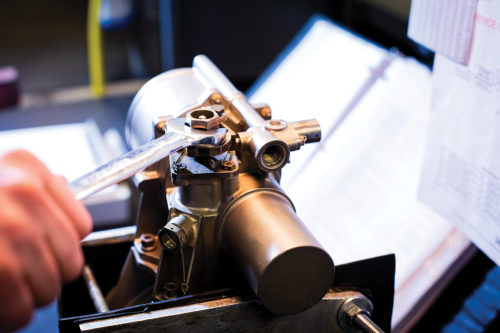What is a DER Repair?

DER (Designated Engineering Representative) repairs are a cost-effective and sustainable alternative to replacing worn-out or damaged aircraft components.
When aircraft operators face the task of dealing with worn out or damaged parts, they typically have two options: replacing the part or repairing it. While both options can be solutions in terms of keeping the plane in operation, they come with distinct cost, time, and sustainability implications. If the part can be repaired, the DER (Designated Engineering Representative) route may be the best course of action. A DER repair is a custom developed repair process in which damaged parts or components are restored back to their applicable airworthiness requirements. Although replacing the damaged part with a new one might seem like a straightforward choice, this approach can be costly, especially when dealing with the OEMs, who are also known for having long lead times. Operators often turn to DER repairs as a cost-effective alternative to replacing expensive components. This can significantly reduce aircraft downtime and contribute to environmental sustainability by minimizing waste. With FAA Designated Engineering Representatives ensuring the safety and reliability of the repair process, DER repairs have become widely used in the aviation industry as a reliable and effective solution.
To understand DER repairs, it is important to understand the role of the Designated Engineering Representative. A DER is a highly skilled aerospace engineer certified by the FAA that specializes in reviewing and approving technical data for repairs, particularly for parts without a repair manual, or for those no longer supported by the OEMs. They play a vital role in ensuring that all repairs adhere to appropriate airworthiness standards, and in guaranteeing the safety and reliability of aircraft components. As highlighted in an article from AVM magazine, different DERs have different specialties. Not all DERs can approve technical data for all parts, as they are categorized based on their specific areas of expertise. These specific areas include Structures, Powerplant Installations, Mechanical Equipment, Electrical Equipment, Radios, Engines, Propellers, Flight Analysts, Flight Test Pilots, and Acoustical. Furthermore, repairs can be split up into two types, “major” and “minor”, depending on the extent of their impact on the aircraft's structural integrity, airworthiness, and flight characteristics. While people often generalize all non-OEM repairs as DER repairs, only major repairs necessitate DER approval, while less impactful repairs can be managed by repair stations and operators without DERs.
Two primary factors are taken into consideration when developing a repair. The first is determining if the part is even repairable at all. There are times when an aircraft component is so severely damaged that a DER repair is simply not feasible or practical. The other factor is whether the cost and lead time of developing the repair will be less than buying a new part altogether. It’s always good to check if there are any PMAs available before succumbing to the considerably higher prices of new OEMs. Once the feasibility of a DER repair has been identified, a systematic repair process designed to repair the damaged component back to its original specifications takes place. All relevant technical data and documentation for the proposed repair is compiled, substantiating its safety and performance. A maintenance manual for the part is effectively created which outlines a repair procedure. This is a complex process as all documentation must be thorough and up to the FAA standards. If necessary, the repaired part is tested by being introduced into a condition/situation that simulates the environment that it would experience during operation of the aircraft. The depth of testing is dependent on the criticality of the part being repaired. Naturally, the more critical a part is deemed, the higher the standard it must meet in order to pass its DER inspection. Once this process is complete with FAA approval secured, MRO facilities and airlines can incorporate the DER approved repair into their maintenance processes.
There are many benefits of opting for a DER repair as opposed to buying a replacement part – with the most the obvious benefit being cost savings. Another noteworthy advantage of DER repairs is their positive environmental impact. Opting for repairs over replacements contributes to resource conservation and waste reduction. Many repairs don’t require rebuilding the entire part, some can be as simple as cleaning a sensor or replacing a switch. By refurbishing and restoring damaged components, the need for new manufacturing is diminished, thereby decreasing the consumption of raw materials and energy typically associated with production. Beyond environmental and economic benefits, DER repairs offer a valuable solution in terms of reduced lead times and streamlined supply chain management. When facing material delays, DER repairs can be game changers for airlines and MRO providers. New OEM replacement parts can involve extended lead times that can take months to fulfill. By utilizing the DER repair method, these lead times can typically be fulfilled in just a couple of weeks. This means airlines can obtain fully functional FAA-approved parts in a fraction of the time, allowing them to promptly resume normal operations and avoid service disruptions.
Jet Parts Engineering has two subsidiary companies that specialize in providing DER repair services: PG Aerotech and Airline Component Parts (ACP). These companies play a crucial role in the MRO industry by offering innovative solutions that repair and restore aircraft components. PG Aerotech, based in Long Island, NY, and ACP, based in Fort Worth, TX, are certified 14 CFR Part 145 repair stations that specialize in electro-mechanical, pneumatic, hydraulic, and mechanical aircraft parts that offer rapid turnaround times, material cost savings, and responsive customer support. Together, PG Aerotech and ACP exemplify Jet Parts Engineering's commitment to providing effective and affordable solutions for the aerospace industry.
